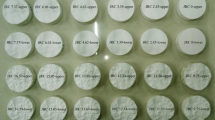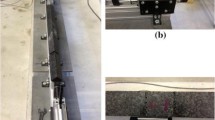Abstract
A series of dynamic tests were carried out to investigate the effect of joint roughness on the wave energy attenuation in rock masses and estimate the relation between joint roughness and seismic quality factor of rock masses. The modified split Hopkinson pressure bar (SHPB) apparatus was adopted in this study, where the loading, input and output bars were made of gypsum. The propagation coefficient of the gypsum bars was measured from trial tests. According to the propagation coefficient of the gypsum bars, the strain, stress and particle velocity on the contact surfaces between the specimen and input/output bars were obtained from the test data recorded by the strain gauges. The specimens were prepared by a three-dimensional printer with plaster and binder. Each specimen modeled a rock mass with one joint with different roughness. The seismic quality factor of specimen is also estimated from the proposed approach of wave energy dissipation. The effects of joint roughness on the seismic quality factor of rock mass and the wave energy attenuation across the rock mass are analyzed from test results.















Similar content being viewed by others
Abbreviations
- Z 2 :
-
Root mean square of the first derivative of the profile curve
- Δx :
-
Scanning interval of points on the profile curve of joint surface
- \({y_i}\) :
-
Vertical height of point on the profile curve of joint surface
- m :
-
Sampling number of the profile curve
- D s :
-
Diameter of the specimen
- l s :
-
Length of the specimen
- Q seismic :
-
Seismic quality factor of rock mass
- ΔW and W :
-
Dissipation energy and maximum deformation energy of the specimen in one cycle of a harmonic excitation
- σ :
-
Stress on the specimen
- ε :
-
Strain of the specimen
- \(\dot {\varepsilon }\) :
-
Strain rate of the specimen
- ε max :
-
Maximum value of strain
- V s :
-
Volume of the specimen
- W I, W R and W T :
-
Energies of incident, reflected and transmitted waves, respectively
- W S :
-
Deformation energy of the specimen
- t :
-
Time
- A and A s :
-
Cross-sectional area of the SHPB bars and specimen, respectively
- ε i, ε r and ε t :
-
Strains caused by the incident, reflected and transmitted waves, respectively, on the input/output bar end contacted to the specimen
- σ i, σ r and σ t :
-
Stress caused by the incident, reflected and transmitted waves, respectively, on the input/output bar end contacted to the specimen
- \({\varepsilon _m}\), \({\sigma _m}\) and \({v_m}\) :
-
Strain, stress and particle velocity caused by the waves on the interfaces between the specimen and input/output bars, respectively, and the subscript m is i, r or t for the incident, reflected and transmitted waves, respectively
- \({\tilde {\varepsilon }_m}\), \({\tilde {\sigma }_m}\) and \({\tilde {v}_m}\) :
-
Fourier forms of the strain, stress and particle velocity caused by the waves on the contact surfaces between the specimen and input/output bars, respectively, and the subscript m is i, r or t for the incident, reflected and transmitted waves, respectively
- \({\tilde {\varepsilon }^{\prime}_m}\) :
-
Fourier forms of strain due to the waves measured by the gauges on the input and output bars, and subscript m is i, r or t for the incident, reflected and transmitted waves, respectively
- x :
-
Distance of wave propagation from the strain gauges to the contact surface between the specimen and input/output bar
- γ :
-
Propagation coefficient of viscoelastic medium
- α and k :
-
Attenuation coefficient and wave number, respectively
References
Aydan Ö (2017) ISRM book series 3: rock dynamics. CRC Press, London
Bacon C (1998) An experimental method for considering dispersion and attenuation in a viscoelastic Hopkinson bar. Exp Mech 38(4):242–249
Barton N, Choubey V (1977) The shear strength of rock joints in theory and practice. Rock Mech Rock Eng 10(1):1–54
Brown SR (1995) Simple mathematical model of a rough fracture. J Geophys Res Solid Earth 100(B4):5941–5952
Brown SR, Scholz CH (1986) Closure of rock joints. J Geophys Res Solid Earth 91(B5):4939–4948
Chen X, Li JC, Cai MF, Zou Y, Zhao J (2015) Experimental study on wave propagation across a rock joint with rough surface. Rock Mech Rock Eng 48(6):2225–2234
Chen X, Li JC, Cai MF, Zou Y, Zhao J (2016) A further study on wave propagation across a single joint with different roughness. Rock Mech Rock Eng 49(7):2701–2709
Fan LF, Wong L (2013) Stress wave transmission across a filled joint with different loading/unloading behavior. Int J Rock Mech Min Sci 60:227–234
Hopkins DL (2000) The implications of joint deformation in analyzing the properties and behavior of fractured rock masses, underground excavations, and faults. Int J Rock Mech Min Sci 37(1):175–202
Johnston DH, Toksoz MN, Timur A (1979) Attenuation of seismic waves in dry and saturated rocks: II. Mechanisms. Geophys 44(4):691–711
Knopoff L (1964) Q. Rev Geophys 2(4):645–654
Kolsky H (1963) Stress waves in solids. Dover Publications, New York
Li JC (2013) Wave propagation across non-linear rock joints based on time-domain recursive method. Geophys J Int 193(2):970–985
Li JC, Li NN, Li HB, Zhao J (2017) An SHPB test study on wave propagation across rock masses with different contact area ratios of joint. Int J Impact Eng 105:109–116
Mohd-Nordin MM, Song KI, Cho GC, Mohamed Z (2014) Long-wavelength elastic wave propagation across naturally fractured rock masses. Rock Mech Rock Eng 47(2):561–573
Ogilvie SR, Isakov E, Glover PWJ (2006) Fluid flow through rough fractures in rocks. II: A new matching model for rough rock fractures. Earth Planet Sci Lett 241(3):454–465
Perino A, Zhu JB, Li JC, Barla G, Zhao J (2010) Theoretical methods for wave propagation across jointed rock masses. Rock Mech Rock Eng 43(6):799–809
Pyrak-Nolte LJ, Myer LR, Cook NGW (1990) Transmission of seismic waves across single natural fractures. J Geophys Res Solid Earth Planet 95(B6):8617–8638
Wu W, Zhu JB, Zhao J (2013) Dynamic response of a rock fracture filled with viscoelastic materials. Eng Geol 160(12):1–7
Yang Z, Lo S, Di C (2001) Reassessing the joint roughness coefficient (JRC) estimation using Z2. Rock Mech Rock Eng 34(3):243–251
Zhao J (1997a) Joint surface matching and shear strength part A: joint matching coefficient (JMC). Int J Rock Mech Min Sci 34(2):173–178
Zhao J (1997b) Joint surface matching and shear strength part B: JRC–JMC shear strength criterion. Int J Rock Mech Min Sci 34(2):179–185
Zhao J, Zhao XB, Cai JG (2006) A further study of P-wave attenuation across parallel fractures with linear deformational behaviour. Int J Rock Mech Min Sci 43(5):776–788
Zhu JB, Perino A, Zhao GF, Barla G, Li JC, Ma GW, Zhao J (2011) Seismic response of a single and a set of filled joints of viscoelastic deformational behaviour. Geophys J Int 186(3):1315–1330
Acknowledgements
The study was supported by Chinese National Science Research Fund (Grant nos. 41525009, 51439008, 41831281).
Author information
Authors and Affiliations
Corresponding author
Additional information
Publisher’s Note
Springer Nature remains neutral with regard to jurisdictional claims in published maps and institutional affiliations.
Rights and permissions
About this article
Cite this article
Li, J.C., Rong, L.F., Li, H.B. et al. An SHPB Test Study on Stress Wave Energy Attenuation in Jointed Rock Masses. Rock Mech Rock Eng 52, 403–420 (2019). https://doi.org/10.1007/s00603-018-1586-y
Received:
Accepted:
Published:
Issue Date:
DOI: https://doi.org/10.1007/s00603-018-1586-y




